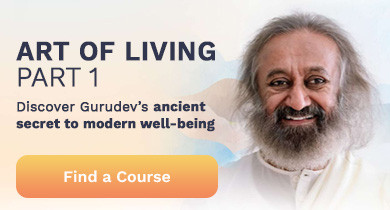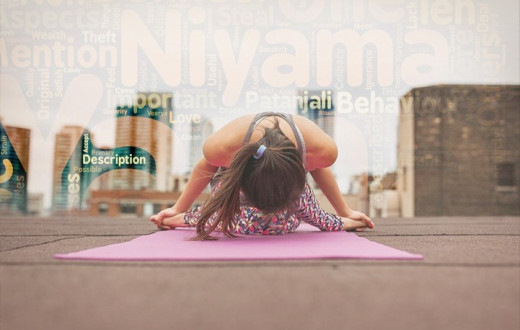Those who suffer from joint pain know that finding a fulfilling and pain-free mode of exercise can be a difficult and frustrating process. Whether it be your knees, wrists, shoulders, or fingers, staying active with arthritis is no easy task. High-impact forms of exercise that place pressure on the joints, such as running, stepping, and jump rope, can cause excessive wear and tear on the cartilage. For those who already suffer from arthritis, high-impact exercises lead to pain and potential injury.
However, while certain types of exercise do indeed worsen joint pain, exercise is vital, especially for people with arthritis. Not only does regular physical activity maintain overall health, but the right forms can actually reduce joint pain and aid the healing process.
As we age, the chances of joint pain increase. Weak bones, lack of adequate physical exercise, and lack of essential nutrients in the diet can contribute to and aggravate arthritis. While medication helps to alleviate pain, natural, time-tested methods like yoga can accelerate the process of eliminating pain altogether.
Yoga is an ideal form of exercise for those who suffer from joint pain, as it is a low-impact exercise that provides natural arthritis pain relief by strengthening the muscles around the joints, helping to maintain bone strength, and increasing flexibility. Even better, yoga is a practice that can be adapted to fit your individual needs! Whether you desire a gentle practice that brings subtle movement to achy elbows, or a more rigorous practice that avoids placing pressure on the knees, yoga meets you where you are. It can even be done in a chair!
Try out the below postures to strengthen and heal your joints. Be sure to listen to your body and ease up on any pose that causes pinching or pain!
Basic Yoga Postures Like The Following Ones Will Heal Your Joints And Strengthen Them:
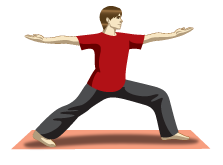
- Stand straight with your legs wide apart by a distance of
- at least 3-4 feet.
- Turn your right foot out by 90 degrees and left foot in by
- about 15 degrees.
- Lift both arms sideways to shoulder height with your
- palms facing upwards.
- Breathing out, bend your right knee.
- Checkpoint: Are your right knee and right ankle forming
- a straight line? Ensure that your knee does not overshoot the ankle.
- Turn your head and look to your right.
- As you settle down in the yoga posture stretch your arms further.
- Make a gentle effort to push your pelvis down. Hold the yoga posture with the determination of a warrior. Smile like a happy smiling warrior. Keep breathing as you go down.
- Breathing in, come up.
- Breathing out, bring your hands down from the sides.
- Repeat the yoga posture for the left side (turn your left foot out by 90 degrees and turn the right foot in by about 15 degrees).
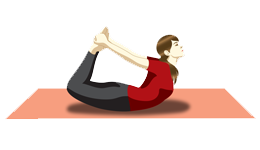
- Lie on your stomach with your feet hip-width apart and your arms by the side of your body.
- Fold your knees and hold your ankles.
- Breathing in, lift your chest off the ground and pull your legs up and back.
- Look straight ahead with a smile on your face. Curve your lips to match the curve of your body!
- Keep the pose stable while paying attention to your breath. Your body is now taut as a bow.
- Continue to take long deep breaths as you relax in this pose. But don’t get carried away! Do not overdo the stretch.
- After 15 -20 seconds, as you exhale, gently bring your legs and chest to the ground. Release the ankles and relax.
Bow pose opens the shoulders and increases flexibility in the back.Regularly practicing bow pose can lead to Relief of lower back pain.

- To begin, lie on your back.
- Fold your knees and keep your feet hip distance apart on the floor, 10-12 inches from your pelvis, with knees and ankles in a straight line.
- Keep your arms beside your body, palms facing down.
- Inhaling, slowly lift your lower back, middle back and upper back off the floor; gently roll in the shoulders; touch the chest to the chin without bringing the chin down, supporting your weight with your shoulders, arms and feet. Feel your bottom firm up in this pose. Both the thighs are parallel to each other and to the floor.
- If you wish, you could interlace the fingers and push the hands on the floor to lift the torso a little more up, or you could support your back with your palms.
- Keep breathing easily.
- Hold the posture for a minute or two and exhale as you gently release the pose.
Bridge pose helps strengthen muscles in the knee and is also helpful for those suffering from osteoporosis. It calms the brain and reduces anxiety and stress in the body.
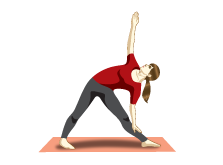
- Stand straight. Separate your feet comfortably wide apart (about 31/2 to 4 ft).
- Turn your right foot out 90 degrees and left foot in by 15 degrees.
- Now align your center of right heel with the center of your arch of left foot.
- Inhale deeply and as you exhale, bend your body to the right, downward from the hips, keeping the waist straight, allowing your left hand to come up in the air while your right hand comes down towards floor. Keep both arms in straight line.
- Rest your right hand on your shin, ankle, or the floor outside your right foot, whatever is possible without distorting the sides of the waist. Stretch your left arm toward the ceiling, in line with the tops of your shoulders. Keep your head in a neutral position or turn it to the left, eyes gazing softly at the left palm.
- As you inhale, come up, bring your arms down to your sides, and straighten your feet.
- Repeat the same on the other side.
Triangle pose strengthens the legs, knees and ankles. It also stretches and opens the hamstrings, groin and hips. This yoga pose can help relieve the body of sciatica and back pain.
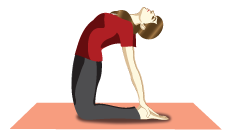
- Kneel on the yoga mat and place your hands on the hips.
- Your knees should be in line with the shoulders and the sole of your feet should be facing the ceiling.
- As you inhale, draw in your tail-bone towards the pubis as if being pulled from the navel.
- Simultaneously, arch your back and slide your palms over your feet till the arms are straight.
- Do not strain or flex your neck but keep it in a neutral position.
- Stay in this posture for a couple of breaths.
- Breathe out and slowly come back to the initial pose. Withdraw your hands and bring them back to your hips as you straighten up.
An effective back pain exercise and shoulder strengthening pose, Ustrasana improves flexibility of the spine, improves posture, and relieves low back pain.
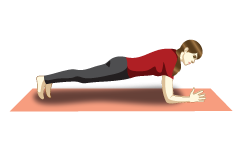
- Begin in Adho Mukha Svanasana and slowly shift the weight of the body to the front.
- Ensure that your shoulders are aligned with your wrists.
- Slowly, lower your arms till the forearms touch the floor. Your palms should be pressed to the floor.
- Keeping your legs straight, position your heels directly above the toes.
- Fix your gaze on the floor and keep your back and knees straight.
- If possible, the palms should be facing each other.
- As you inhale, slowly pull your abdominal muscles in and relax them as you exhale.
- Stay in this posture for a few breaths before returning back to Adho Mukha Svanasana
Dolphin Plank pose stretches the shoulders and hamstrings, and strengthens the wrists, arms and legs.
A Word Of Caution:
Make use of yoga blocks, cushions and support while practicing these poses to avoid aggravation of pain. Respect your body's limit and do only as much as you comfortably can. In case the pain aggravates, discontinue the practice and seek medical consultation before resuming.
Pain-Free Tips For Being Pain-Free:
- Get up from your desk and stretch once every hour.
- Maintain good posture while sitting and standing
- Avoid over-stressing your joints
- Eat anti-inflammatory food
- Increase muscle mass
Eat Right!
Joints are junctions where bones meet and enable functions such as rotation, bending, rolling and gliding. Keeping these junctions healthy and functional is not as daunting a task as it may seem. One of the first steps to healthier joints starts with making joint-friendly food choices. Experts suggest that reducing intake of inflammatory foods such as sugar and gluten, and increasing intake of anti-inflammatory foods such as green-leafy vegetables, nuts, and fruit can help reduce joint pain and create the conditions for repair.
If you feel that joint pain holds you back from maximizing your physical potential, adopt yoga as a regular practice and discover the amazing power, strength, and flexibility that your body is capable of, regardless of pre-existing joint pain. The effects of yoga take time to manifest, so be patient, don’t give up, and prepare to reap the pain-free rewards of your practice!
While a regular yoga practice can result in increased health, know that it is not a substitute for medical treatment. It is important to learn and practice yoga postures under the supervision of a trained teacher. In the case of a medical condition, practice yoga postures after consulting a doctor. Find an Sri Sri Yoga course at an Art of Living Center near you.
